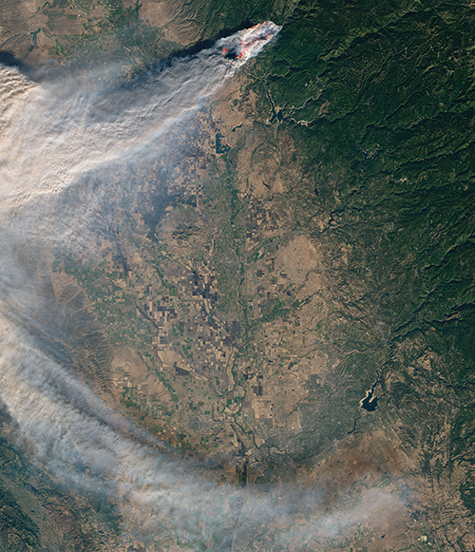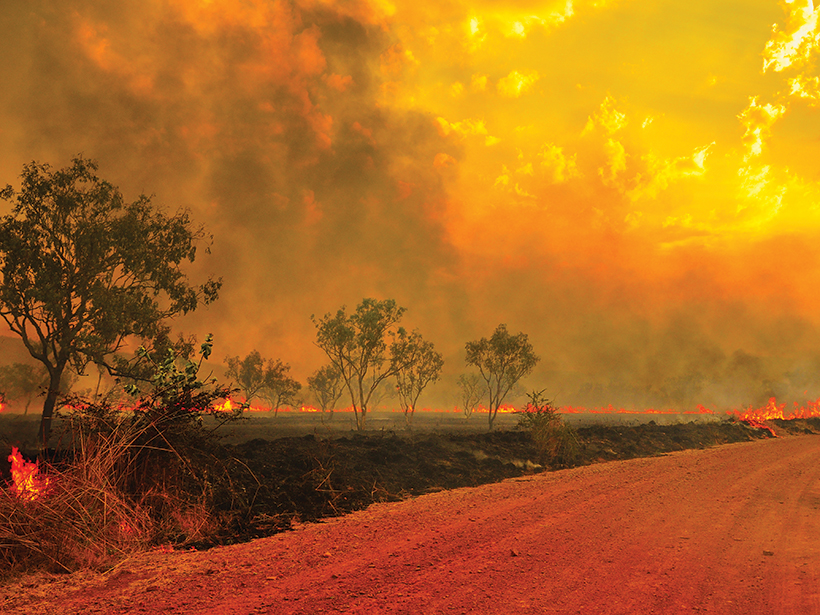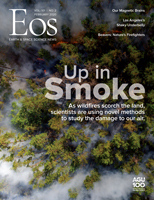It’s August 2019, and Carsten Warneke is hunting for smoke. On board a NASA DC-8 aircraft packed with instruments, Warneke and other researchers have been locating and flying through smoke plumes from wildfires across the western United States for several weeks.
Warneke, an atmospheric chemist at the University of Colorado Boulder and the National Oceanic and Atmospheric Administration (NOAA), is part of the Fire Influence on Regional to Global Environments and Air Quality (FIREX-AQ) project, a joint venture led by NOAA and NASA. A major goal of FIREX-AQ, according to the project’s website, is to study “the chemistry and composition of smoke from wildfire and agricultural burning to improve weather, air quality, and climate forecasts.” FIREX-AQ is just one of several research projects worldwide geared toward enhancing our understanding of how fires affect climate (and vice versa) and accurately incorporating fires and their smoky repercussions into regional and global climate models.
Earth is always burning. From 2003 to 2016, more than 13 million fires of various sizes and intensities flamed and smoldered across the planet. The United States alone has averaged nearly 67,000 fires annually in the past decade, with more than 46,000 fires occurring in 2019 as of late November. Worldwide, large expanses of Siberia have been aflame, with the fires sometimes covering areas the size of the state of Massachusetts. In South America, tens of thousands of fires have blazed through the Amazon, the world’s largest tropical rain forest, and thousands more have burned in the Pantanal, the world’s largest tropical wetland. Bushfires rage across the Australian state of New South Wales, lowering air quality in nearby areas to unprecedented levels.
“Most climate models currently do not include a representation of interactive wildfires, or, even if they do, this is done in a somewhat unsuccessful or limited way.”
Wildfires can be anthropogenic, started accidentally or on purpose to clear forests for farming or animal husbandry, or to burn crop stubble on agricultural fields in preparation for a new planting season. Fires can also occur naturally—ignited by lightning strikes, for example.
Researchers agree that fires, whether large or small, human-made or natural, can significantly affect local, regional, and global climates in a variety of ways. Nonetheless, modeling the exact nature of these effects has been difficult. In fact, “most climate models currently do not include an interactive representation of wildfires, or, even if they do, the representation of such feedbacks has not been properly validated, given how recent a development this is,” said Apostolos Voulgarakis, an atmospheric physicist at Imperial College London. There are several reasons fires and their emissions are difficult to incorporate into climate models, including differences in scale between fires and climate models; the speed with which fire emissions evolve once they enter the atmosphere; and feedbacks between fires and a changing climate.
Scaling: The Challenge
There are many drivers of global climate: Sunlight, cloud formations, and wildfire emissions all influence climate on local, regional, and global scales. These differences in scale matter tremendously because of how most modern global climate models are built.
In general, today’s climate models divide Earth’s surface into a 3-D grid. Each cell in this grid stretches north–south and east–west, and there are depths of atmosphere represented by multiple stacked cells. The models enforce fundamental laws of physics and use mathematical equations to represent processes taking place in Earth’s oceans, land areas, atmosphere, and sea and land ice. They then calculate how various climate drivers force, or influence, these processes. The models simulate climate within each grid cell over a selected time step (usually minutes or hours) and calculate how each cell affects neighboring ones, ultimately cobbling together a snapshot of global climate. The whole process of these calculations is then repeated over multiple time steps until the desired overall time span (years, decades, or centuries) is completed.
Wind can heavily influence fire behavior, but on the grid scales of global climate models, “there is no hope of being able to represent small-scale wind patterns or terrain characteristics that influence the progression of fires.”
The size of grid cells determines the spatial resolution of a climate model. Smaller cells provide higher resolution but are much more computationally intensive and time-consuming. If each cell in a model represents 2° latitude × 2° longitude (roughly 200 × 200 kilometers at the surface near the equator), for example, and the model contains 20–40 vertical atmospheric layers, the model has to solve equations for almost half a million grid cells at each time step. And if the specified time step is half an hour, the model has to run calculations more than 1.7 million times for each grid cell to simulate global climate for 100 years.
So “when modeling global climate and wildfires at the same time, compromises need to be made,” Voulgarakis said. “Certain processes cannot be represented adequately in existing climate model resolutions, with a prominent example being wind influences on wildfires.”
Wind can heavily influence fire behavior, but on the grid scales of global climate models, “there is no hope of being able to represent small-scale wind patterns or terrain characteristics that influence the progression of fires,” Voulgarakis said. (Global climate models skirt this issue by using a process called parameterization: averaging values, such as the height of surface features or the climate effects of cumulus clouds, over entire cells or using expected values based in part on past observations for these subcell-scale processes.)
Adam Kochanski, an atmospheric scientist at the University of Utah, noted that “the spatial scales of flames, where combustion actually occurs, are tiny compared [with] the scales relevant to climate problems” but also said that grid spacings used in regional climate models (versus global ones) “are approaching the resolutions needed to link fires with local climate capturing the fire–atmosphere feedbacks.”
Kochanski is part of a National Science Foundation–funded project led by Steve Krueger to develop the Multistage Wildfire Research and Prediction System (MWRPS), which aims to model fire–atmosphere interactions at a very small scale. “To successfully attack this problem, we will need a new class of reduced-complexity models that will be fast enough to be executed for large regions typically covered by climate models but at the same time [will] be able to render fire–atmosphere interactions,” he said.
A Need for Speed
Another difficulty in adding fires into climate models is the speed with which fire emissions evolve in the atmosphere. In addition to ash, fires emit large amounts of reactive particles and gases (such as carbon dioxide, ozone, and methane) into the atmosphere, but “how these emissions affect air quality and climate depends on both what is emitted and how it evolves,” said Emily Fischer, an atmospheric scientist at Colorado State University. “There are a lot of changes in the chemistry of smoke within the first few hours of its entry into the atmosphere.” Without completely understanding how smoke chemistry changes over time, researchers cannot build accurate climate models that account for fire emissions.
Fischer is part of a National Science Foundation–funded program called the Western Wildfire Experiment for Cloud Chemistry, Aerosol Absorption and Nitrogen (WE-CAN) project. The goal of WE-CAN is to “systematically characterize the emissions and first day of evolution of western U.S. wildfire [smoke] plumes,” according to the project’s website. In summer 2018, WE-CAN deployed a C-130 aircraft to sample fresh smoke from wildfires.

How chemicals in wildfire smoke evolve depends in part on atmospheric conditions like temperature and humidity. Those conditions can change with altitude and geographic location, so “the evolution of these [wildfire emissions] depends acutely on where they are injected into the atmosphere,” Fischer and her colleagues wrote in a recent study.
Most emissions are released close to the ground, but it’s difficult for research aircraft to fly low over wildfires (and for ground-based teams to approach closely on foot). “We estimate that the earliest we sampled a smoke plume was 18–20 minutes after its formation,” Fischer said. Sometimes, however, the plumes would be more than an hour old by the time measurements took place, long enough for the chemicals initially in the emissions to evolve into secondary compounds. Fortunately, Fischer and the WE-CAN team reached the plumes soon enough to be able to back-calculate levels and compositions of primary emissions based on the secondary compounds they detected.
Fischer and her colleagues are still analyzing the data collected by the WE-CAN flights, but they have already found some intriguing results. For example, “there is quite a lot of variability in the amount of reactive nitrogen species versus carbon compounds emitted even in the 20 or so fires we studied,” she said. “We have compared these field data to lab measurements and [found that] burn conditions are driving some of the differences, but we don’t understand all the reasons why.” Although researchers are still exploring exactly how reactive nitrogen species affect climate, it is known that some of these compounds, such as nitrous oxide (N2O), are strong greenhouse gases.
The Feedback Conundrum
One of the biggest challenges in incorporating fires into climate models is the two-way nature of the relationship between climate and wildfires. Fires affect climate, but weather and climate also influence fires.
One of the biggest challenges in incorporating fires into climate models is the two-way nature of the relationship between climate and wildfires. Fires affect climate, but weather and climate also influence fires. “For instance, fire smoke affects surface temperatures and winds that in turn impact the fire behavior itself, as well as smoke production and dispersion,” Kochanski said.
Kochanski is part of a group of researchers, including Jan Mandel, who have coupled a widely used weather forecast model (the Weather Research and Forecasting (WRF) model) with a model called SFIRE, which simulates how fire spreads. The result is WRF-SFIRE, a freely shared model that allows researchers to connect fires and atmospheric effects. It also allows linking of a chemistry module (WRF-SFIRE-CHEM), which adds simulations of emissions from fires based on fuel consumption rates and then models the chemical and physical changes of these emissions once they enter the atmosphere.
Feedbacks between fires and climate make it difficult to validate models, though. “Fire behavior and the local micrometeorology need to be sampled simultaneously to characterize all the processes shaping local weather and provide comprehensive data sets we can use to develop and validate models,” Kochanski said. But that’s easier said than done; an average forest fire can reach temperatures above 800°C (1,472°F). “As you can imagine, collecting such data in the wildfire environment is very difficult, and often impossible, due to safety concerns,” Kochanski said.
But researchers are working on that: FIREX-AQ is one example of these attempts. In the summer and fall of 2019, the project (a collaboration between four federal agencies, more than 20 universities, and several private partners) used multiple aircraft, ground-based crews, and satellites simultaneously to gather information about smoke and emissions both from wildfires in the western United States and from prescribed agricultural fires in the southeastern United States. One aircraft focused on how emissions from fires changed with time, how these emissions evolved in the atmosphere, and how their distribution varied with altitude. A different aircraft collected meteorological data, including on the winds affected by the fire and how these winds in turn influenced emissions transport. “We are trying to look at fires holistically; that’s the only way to get all the measurements you need to build robust climate models that incorporate fires,” Warneke said.
Going Small for Big Understandings
Accurately measuring emissions from fires and understanding how they evolve in the atmosphere are big steps in building global climate models, but they’re only part of the puzzle.
How primary emissions, and the secondary particles into which they evolve, affect atmospheric and climatic processes is another key piece. To understand these effects, Rajan Chakrabarty, an environmental and chemical engineer at Washington University in St. Louis, has gone to the microscopic level. “We study, for example, how the shape, mass, and optical properties of specific emissions change inside fires and then outside them,” Chakrabarty said.
One type of fire emission that Chakrabarty has studied is black carbon, a particulate emission resulting from the incomplete combustion of carbonaceous materials like fossil fuels, agricultural leftovers, and other biomass. These tiny particulates strongly absorb sunlight, thus warming the atmosphere and changing cloud dynamics. Although they are relatively short-lived in the atmosphere, black carbon particles can still travel long distances through the atmosphere and be deposited in snowy or icy regions on land (such as in the Arctic or the Himalaya). In these regions, they can have myriad effects, including reducing the amount of sunlight reflected by snow and ice, and increasing melting, which in turn contribute to climate warming.
Chakrabarty and colleagues were the first to discover that large, open fires, such as wildfires, emit a form of black carbon different from that seen in emissions from automobile exhaust or from domestic cooking or heating. Black carbon in wildfire emissions forms larger aggregates, called percolated aggregates, or PAs, that have significantly different optical properties and absorb more incoming solar radiation of certain wavelengths. “These observations suggest that soot PAs may have…previously unaccounted for impacts on climate forcing,” according to Chakrabarty.
Whereas blazing forest fires emit large amounts of black carbon, smoldering fires, such as those seen when peatlands burn, emit different aerosols and particulates. Chakrabarty and colleagues have shown that peat fires emit mostly brown carbon and almost no black carbon. Unlike black carbon, which absorbs light across the visible spectrum, brown carbon absorbs near-ultraviolet and blue light, reflecting green, yellow, and red wavelengths.
“Initially, people thought that brown carbon particles would act like a mirror, because they reflect some light, and so offset the warming effects of black carbon in the atmosphere,” Chakrabarty said. But his research has shown that brown carbon particles can absorb certain wavelengths of light that contribute to warming more strongly than black carbon particles. “So now we know [that] these particles can actually increase the net warming effects of black carbon.”
Fires, from smoldering peat fires to blazing forest fires to the hazy burnings of farm stubble, are incredibly complex. Researchers are making progress in understanding the behaviors of different kinds of fires, the intricacies and evolution of their emissions, and the interactions of fires with the environment—all knowledge that is vital in improving the accuracy of climate models. There is a long way to go, however, and no time to waste as risks posed by wildfires to communities continue to grow and the climate continues to change. “We need to know these details [related to fires and emissions],” Warneke said, “to make accurate predictions of air quality and [to] model global climate.”
Author Information
Adityarup Chakravorty ([email protected]), Science Writer
Citation:
Chakravorty, A. (2020), Firing up climate models, Eos, 101, https://doi.org/10.1029/2020EO138265. Published on 27 January 2020.
Text © 2020. The authors. CC BY-NC-ND 3.0
Except where otherwise noted, images are subject to copyright. Any reuse without express permission from the copyright owner is prohibited.


